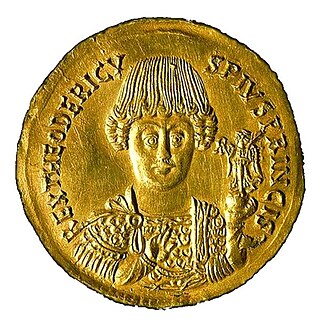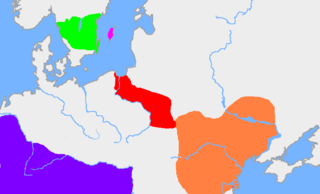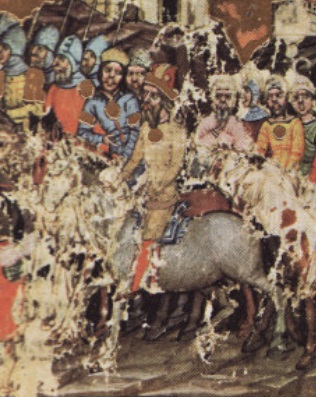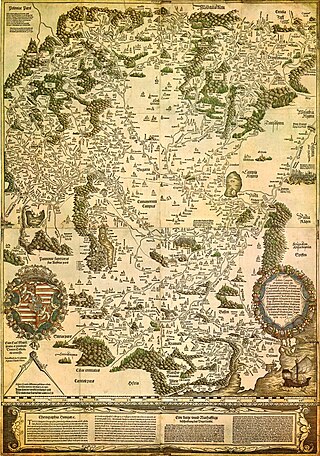Related Research Articles

The Marcomanni were a Germanic people that established a powerful kingdom north of the Danube, somewhere near modern Bohemia, during the peak of power of the nearby Roman Empire. According to Tacitus and Strabo, they were Suebian.

The Ostrogoths were a Roman-era Germanic people. In the 5th century, they followed the Visigoths in creating one of the two great Gothic kingdoms within the Roman Empire, based upon the large Gothic populations who had settled in the Balkans in the 4th century, having crossed the Lower Danube. While the Visigoths had formed under the leadership of Alaric I, the new Ostrogothic political entity which came to rule Italy was formed in the Balkans under the influence of the Amal dynasty, the family of Theodoric the Great.
Year 454 (CDLIV) was a common year starting on Friday of the Julian calendar. At the time, it was known as the Year of the Consulship of Aetius and Studius. The denomination 454 for this year has been used since the early medieval period, when the Anno Domini calendar era became the prevalent method in Europe for naming years.

The Heruli were an early Germanic people. Possibly originating in Scandinavia, the Heruli are first mentioned by Roman authors as one of several "Scythian" groups raiding Roman provinces in the Balkans and the Aegean Sea, attacking by land, and notably also by sea. During this time they reportedly lived near the Sea of Azov.

The Rugii, Rogi or Rugians, were a Roman-era Germanic people. They were first clearly recorded by Tacitus, in his Germania who called them the Rugii, and located them near the south shore of the Baltic Sea. Some centuries later, they were considered one of the "Gothic" or "Scythian" peoples who were located in the Middle Danube region. Like several other Gothic peoples there, they possibly arrived in the area as allies of Attila until his death in 453. They settled in what is now Lower Austria after the defeat of the Huns at Nedao in 454.

The Gepids were an East Germanic tribe who lived in the area of modern Romania, Hungary and Serbia, roughly between the Tisza, Sava and Carpathian Mountains. They were said to share the religion and language of the Goths and Vandals.

The Battle of Nedao was fought in Pannonia in 454 CE between the Huns and their former Germanic vassals. Nedao is believed to be a tributary of the Sava River.

The Sciri, or Scirians, were a Germanic people. They are believed to have spoken an East Germanic language. Their name probably means "the pure ones".

The Ostrogothic Kingdom, officially the Kingdom of Italy, existed under the control of the Germanic Ostrogoths in Italy and neighbouring areas from 493 to 553.
Dengizich, was a Hunnic ruler and son of Attila. After Attila's death in 453 AD, his empire crumbled and its remains were ruled by his three sons, Ellac, Dengizich and Ernak. He succeeded his older brother Ellac in 454 AD, and probably ruled simultaneously over the Huns in dual kingship with his brother Ernak, but separate divisions in separate lands.
Ardaric was the king of the Gepids, a Germanic tribe closely related to the Goths. He was "famed for his loyalty and wisdom," one of the most trusted adherents of Attila the Hun, who "prized him above all the other chieftains." Ardaric is first mentioned by Jordanes as Attila's most prized vassal at the Battle of the Catalaunian Plains (451):
Valamir or Valamer was an Ostrogothic king in the former Roman province of Pannonia from AD 447 until his death. During his reign, he fought alongside the Huns against the Roman Empire and then, after Attila the Hun's death, fought against the Huns to consolidate his independent control over a large group of Goths.

Ellac was the oldest son of Attila (434–453) and Kreka. After Attila's death in 453 AD, his empire crumbled, and its remains were ruled by his three sons, Ellac, Dengizich and Ernak. He ruled briefly and died at the Battle of Nedao in 454 AD. Ellac was succeeded by his brothers, Dengizich and Ernak.

The Greuthungi were a Gothic people who lived on the Pontic steppe between the Dniester and Don rivers in what is now Ukraine, in the 3rd and the 4th centuries. They had close contacts with the Tervingi, another Gothic people, who lived west of the Dniester River. To the east of the Greuthungi, living near the Don river, were the Alans.

Balamber was ostensibly a chieftain of the Huns, mentioned by Jordanes in his Getica. Jordanes simply called him "king of the Huns" and writes the story of Balamber crushing the tribes of the Ostrogoths in the 370s; somewhere between 370 and more probably 376 AD.
The Battle of Bassianae took place between the Ostrogoths and the Huns in 468. Recovering from the defeat at Nedao in 454, the Hunnic leader Dengizich launched an invasion across the Danube with a large Hun force, but was defeated by the Ostrogothic king Valamir. Jordanes writes that in turn the Huns "for ever after" left the Goths in peace.
The history of the Huns spans the time from before their first secure recorded appearance in Europe around 370 AD to after the disintegration of their empire around 469. The Huns likely entered Western Asia shortly before 370 from Central Asia: they first conquered the Goths and the Alans, pushing a number of tribes to seek refuge within the Roman Empire. In the following years, the Huns conquered most of the Germanic and Scythian tribes outside of the borders of the Roman Empire. They also launched invasions of both the Asian provinces of Rome and the Sasanian Empire in 375. Under Uldin, the first Hunnic ruler named in contemporary sources, the Huns launched a first unsuccessful large-scale raid into the Eastern Roman Empire in Europe in 408. From the 420s, the Huns were led by the brothers Octar and Ruga, who both cooperated with and threatened the Romans. Upon Ruga's death in 435, his nephews Bleda and Attila became the new rulers of the Huns, and launched a successful raid into the Eastern Roman Empire before making peace and securing an annual tribute and trading raids under the Treaty of Margus. Attila appears to have killed his brother and became sole ruler of the Huns in 445. He would go on to rule for the next eight years, launching a devastating raid on the Eastern Roman Empire in 447, followed by an invasion of Gaul in 451. Attila is traditionally held to have been defeated in Gaul at the Battle of the Catalaunian Fields, however some scholars hold the battle to have been a draw or Hunnic victory. The following year, the Huns invaded Italy and encountered no serious resistance before turning back.
Hunimund was a leader - variously described by Jordanes as dux and as rex - of group of Suebi.

Concó is a river in northern Hungary, a tributary of the Danube. It rises in Fejér County and enters the Danube in Komárom-Esztergom County near the city of Komárom.

The timeline of Hungarian history lists the important historical events that took place in the territory of Hungary or are closely connected to the history of the country. The subsequent events encompass the timeline spanning from Classical Antiquity through the High Middle Ages, specifically up to the 1030s.
References
- 1 2 Reynolds, Robert L.; Lopez, Robert S. (1946). "Odoacer: German or Hun?". The American Historical Review. 52 (1): 40. doi:10.2307/1845067.
In the opening clashes the Ostrogothic king, Valamir, father of Theodoric the Great, lost his life; but shortly after, the Sciri met with crushing defeat near the Bolia river (468 A.D.),
- 1 2 3 4 Wolfram, Herwig (1990). "The Ostrogothic Kingdom in Pannonia". History of the Goths. Berkeley, California: University of California Press. pp. 264–265. ISBN 978-0-520-06983-1.
- 1 2 3 Gračanin, Hrvoje; Škrgulja, Jana (2014). "The Ostrogoths in Late Antique Southern Pannonia". Acta Archaeologica Carpathica. 49: 165–205, page 176.
- ↑ Christie, Neil (2007). "From the Danube to the Po: The defence of Pannonia and Italy in the fourth and fifth centuries AD". In Poulter, Andrew G. (ed.). The Transition to Late Antiquity, On the Danube and Beyond. Proceedings of the British Academy. Oxford, England: Oxford University Press. pp. 547–580. ISBN 978-0-19-726402-7.
- ↑ Maenchen-Helfen, Otto (1973). The World of the Huns: Studies in Their History and Culture . Translated by Knight, Max. Berkeley, California: University of California Press. pp. 143–144. ISBN 978-0-520-01596-8.
- 1 2 Hodgkin, Thomas (1891). Theodoric the Goth: The Barbarian Champion of Civilization. New York: G. P. Putnam's Sons. p. 29. OCLC 218093.
- ↑ Wolfram 1990 , p. 259
- ↑ Kim, Hyun Jin (2013). The Huns, Rome and the Birth of Europe. Cambridge, England: Cambridge University Press. p. 113. ISBN 978-1-107-00906-6.
- ↑ Wolfram 1990 , p. 260
- ↑ While Jordanes, and most other authors, state that the Ostrogoths won, Kim states that they lost, apparently based upon the fact that they subsequently moved south further into the Roman Empire. Kim, Hyun Jin (2015). Huns. Milton Park, Oxfordshire: Routledge. p. 119. ISBN 978-1-317-34090-4.
- ↑ For example Thompson, E. A. (2002). Romans and Barbarians: The Decline of the Western Empire. Madison, Wisconsin: University of Wisconsin Press. p. 19. ISBN 978-0-299-08704-3., originally published in 1982.
- ↑ This identification was made in 1934 in the second edition of his book on the eastern Germanic tribes. Schmidt, Ludwig (1934). Geschichte der deutschen Stämme bis zum Ausgang der Völkelrwanderung: Die Ostgermanen (in German) (second ed.). Munich: C.H. Beck. p. 275. OCLC 895461758., and followed by Wolfram, as stated in his review by Émilienne, Demougeot (1983). "Herwig Wolfram, Geschichte der Goten, 1979". Revue des Études Anciennes (in French). 85 (3): 314–319. using the 1941 printing of Schmidt.
- ↑ See authors cited at Gračanin, Hrvoje; Škrgulja, Jana (2014). "The Ostrogoths in Late Antique Southern Pannonia". Acta Archaeologica Carpathica. 49: 165–205, page 176, note 64.
- ↑ Émilienne 1983 , p. 318
- ↑ Jordanes Getica LIII (paragraph 278)